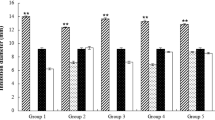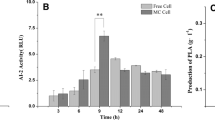Abstract
Lactobacillus plantarum NMD-17 separated from koumiss could produce a bacteriocin named plantaricin MX against Gram-positive bacteria and Gram-negative bacteria. The bacteriocin synthesis of L. plantarum NMD-17 was remarkably induced in co-cultivation with Lactobacillus reuteri NMD-86 as the increase of cell numbers and AI-2 activity, and the expressions of luxS encoding signal AI-2 synthetase, plnB encoding histidine protein kinase, plnD encoding response regulator, and plnE and plnF encoding structural genes of bacteriocin were significantly upregulated in co-cultivation, showing that the bacteriocin synthesis of L. plantarum NMD-17 in co-cultivation may be regulated by LuxS/AI-2-mediated quorum sensing system. In order to further demonstrate the role of LuxS/AI-2-mediated quorum sensing system in the bacteriocin synthesis of L. plantarum NMD-17, plasmids pUC18 and pMD18-T simple were used as the skeleton to construct the suicide plasmids pUC18-UF-tet-DF and pMD18-T simple-plnB-tet-plnD for luxS and plnB-plnD gene deletion, respectively. luxS and plnB-plnD gene knockout mutants were successfully obtained by homologous recombination. luxS gene knockout mutant lost its AI-2 synthesis ability, suggesting that LuxS protein encoded by luxS gene is key enzyme for AI-2 synthesis. plnB-plnD gene knockout mutant lost the ability to synthesize bacteriocin against Salmonella typhimurium ATCC14028, indicating that plnB-plnD gene was a necessary gene for bacteriocin synthesis of L. plantarum NMD-17. Bacteriocin synthesis, cell numbers, and AI-2 activity of luxS or plnB-plnD gene knockout mutants in co-cultivation with L. reuteri NMD-86 were obviously lower than those of wild-type strain in co-cultivation at 6–9 h (P < 0.01). The results showed that LuxS/AI-2-mediated quorum sensing system played an important role in the bacteriocin synthesis of L. plantarum NMD-17 in co-cultivation.









Similar content being viewed by others
Data availability
The data that support the findings of this study are available from the corresponding author upon reasonable request.
References
Ahmed AA, Salih FA (2019) Quercus infectoria gall extracts reduce quorum sensing-controlled virulence factors production and biofilm formation in Pseudomonas aeruginosa recovered from burn wounds. BMC Complem Altern M 19:177–187
Anastasiadou S, Papagianni M, iliousis G, Ambrosiadis I, Koidis P (2008) Pediocin SA-1, an antimicrobial peptide from Pediococcus acidilactici NRRL B5627: production conditions, purification and characterization. Bioresource Technol 99:5384–5390
Asanuma N, Yoshii T, Hino T (2004) Molecular characterization and transcription of the luxS gene that encodes LuxS autoinducer 2 synthase in Streptococcus bovis. Curr Microbiol 49:366–371
Ascenso OS, Marques JC, Santos AR, Xavier KB, Ventura MR, Maycock CD (2011) An efficient synthesis of the precursor of AI-2, the signalling molecule for inter-species quorum sensing. Bioorgan Med Chem 19:1236–1241
Axelsson L, Holck A (1995) The genes involved in production of and immunity to sakacin A, a bacteriocin from Lactobacillus sakei Lb706. J Bacteriol 177:2125–2137
Bowdish DME, Davidson DJ, Hancock RE (2005) A re-evaluation of the role of host defence peptides in mammalian immunity. Curr Protein Pept Sc 6(1):35–51
Cavicchioli VQ, Todorov SD, Iliev I, Ivanova I, Drider D, Nero LA (2019) Physiological and molecular insights of bacteriocin production by Enterococcus hirae ST57ACC from Brazilian artisanal cheese. Braz J Microbiol 50:369–377
Dai JY, Fang LM, Zhang MM, Deng HL, Cheng X, Yao MY, Huang L (2022) Isolation and identification of new source of bacteriocin-producing Lactobacillus plantarum C010 and growth kinetics of its batch fermentation. World J Microb Biot 38:67
De Giani A, Bovio F, Forcella M, Fusi P, Sello G, Di Gennaro P (2019) Identification of a bacteriocin-like compound from Lactobacillus plantarum with antimicrobial activity and effects on normal and cancerogenic human intestinal cells. AMB Express 9:88
Funck GD, Marques JDL, Dannenberg GDS, Cruxen CEDS, Sehn CP, Prigol M, Silva MRP, Silva WPD, Fiorentini AM (2020) Characterization, toxicity, and optimization for the growth and production of bacteriocin-like substances by Lactobacillus curvatus. Probiotics Antimicro 12:91–101
Gobbetti M, De Angelis M, Di Cagno R, Minervini F, Limitone A (2007) Cell-cell communication in food related bacteria. Int J Food Microbiol 120(1–2):34–45
Han XG, Lu CP (2009) Detection of autoinducer-2 and analysis of the profile of luxS and pfs transcription in Streptococcus suis serotype 2. Curr Microbiol 58:146–152
Join L, Allan Downie J, Williams P (2007) Bacterial conversations: talking, listening and eavesdropping. Curr Opin Microbiol 3:177–182
Kareb Q, Aïder M (2020) Quorum sensing circuits in the communication mechanisms of bacteria and its implication in the biosynthesis of bacteriocins by lactic acid bacteria: a review. Probiotics Antimicro 12:91–101
Kaur A, Capalash N, Sharma P, Inoue Y, Takata M, Nakatsu Y, Taguchi F, Yamamoto M, Toyoda K, Noutoshi Y, Matsui H (2020) Expression of Meiothermus ruber luxS in E. coli alters the antibiotic susceptibility and biofilm formation. Appl Microbiol Biot 104:4457–4469
Kozlova EV, Popov VL, Sha J, Foltz SM, Erova TE, Agar SL, Horneman AJ, Chopra AK (2008) Mutation in the S-ribosylhomocysteinase (luxS) gene involved in quorum sensing affects biofilm formation and virulence in a clinical isolate of Aeromonas hydrophila. Microb Pathogenesis 45:343–354
Kumari A, Joshua R, Kumar R, Setlhoka MD (2022) Biopreservation of pineapple wine using immobilized and freeze dried microcapsules of bacteriocin producing L. plantarum. J Food Sci Technol 59:745–753
Lazazzera BA (2000) Quorum sensing and starvation: signals for entry into stationary phase. Curr Opin Microbiol 3:177–182
Li P, Li X, Gu Q, Lou XY, Zhang XM, Song DF, Zhang C (2016) Comparative genomic analysis of Lactobacillus plantarum ZJ316 reveals its genetic adaptation and potential probiotic profiles. J Zhejiang Univ-Sc B 17(8):569–579
Li T, Wang D, Liu N, Ma Y, Ding T, Mei Y, Li J (2018a) Inhibition of quorum sensing-controlled virulence factors and biofilm formation in Pseudomonas fluorescens by cinnamaldehyde. Int J Food Microbiol 269:98–106
Li TT, Yang B, Li XP, Li JR, Zhao GH, Kan JQ (2018b) Quorum sensing system and influence on food spoilage in Pseudomonas fluorescens from turbot. J Food Sci Tech Mys 55(8):3016–3025
Man LL, Meng XC, Zhao RH, Xiang DJ (2014) The role of plNC8HK-plnD genes in bacteriocin production in Lactobacillus plantarum KLDS1.0391. Int Dairy J 34:267–274
Man LL, Xiang DJ (2021) LuxS-mediated quorum sensing system in Lactobacillus plantarum NMD-17 from koumiss: induction of plantaricin MX in co-cultivation with certain lactic acid bacteria. Folia Microbiol 66:855–871
Merritt J, Qi F, Goodman SD, Anderson MH, Shi W (2003) Mutation of luxS affects biofilm formation in Streptococcus mutans. Infect Immun 71:1972–1979
Mukherjee S, Bassler BL (2019) Bacterial quorum sensing in complex and dynamically changing environments. Nat Rev Microbiol 17(6):371–382
Navarro L, Rojo-Bezares B, Sáenz Y, Díez L, Zarazaga M, Ruiz-Larrea F, Torres C (2008) Comparative study of the pln locus of the quorum-sensing regulated bacteriocin-producing L. plantarum J51 strain. Int J Food Microbiol 128:390–394
Qiao XX, Du RP, Wang Y, Han Y, Zhou ZJ (2020) Isolation, characterisation and fermentation optimisation of bacteriocin-producing Enterococcus faecium. Waste Biomass Valori 11:3173–3181
Rajkumari J, Borkotoky S, Murali A, Suchiang K, Mohanty SK, Busi S (2018) Cinnamic acid attenuates quorum sensing associated virulence factors and biofilm formation in Pseudomonas aeruginosa PAO1. Biotechnol Lett 40:1087–1100
Sun F, Li N, Wang LJ, Feng HJ, Shen DS, Wang MZ (2020) Iron interferes with quorum sensing-mediated cooperation in Pseudomonas aeruginosa by affecting the expression of ppyR and mexT, in addition to rhlR. J Microbiol 58:938–944
Tai HF, Foo HL, Rahim RA, Loh TC, Abdullah MP, Yoshinobu K (2015) Molecular characterisation of new organisation of plnEF and plw loci of bacteriocin genes harbour concomitantly in Lactobacillus plantarum I-UL4. Microb Cell Fact 14:89
Turcotte C, Lacroix C, Kheadr E, Grignon L, Fliss I (2004) A rapid turbidometric microplate bioassay for accurate quantification of lactic acid bacteria bacteriocins. Int J Food Microbiol 90:283–293
Wang Y, Wang YX, Sun LY, Grenier D, Yi L (2018) The LuxS/AI-2 system of Streptococcus suis. Appl Microbiol Biot 102:7231–7238
Wu S, Liu JH, Liu CJ, Yang A, Qiao JJ (2020) Quorum sensing for population-level control of bacteria and potential therapeutic applications. Cell Mol Life Sci 77:1319–1343
Xiong Q, Liu D, Zhang HH, Dong XV, Zhang GS, Liu YP, Zhang RF (2020) Quorum sensing signal autoinducer-2 promotes root colonization of Bacillus velezensis SQR9 by affecting biofilm formation and motility. Appl Microbiol Biot 104:7177–7185
Xue T, Ni J, Shang F, Chen X, Zhang M (2015) Autoinducer-2 increases biofilm formation via an ica- and bhp-dependent manner in Staphylococcus epidermidis RP62A. Microbes Infect 17:345–352
Yang Q, Defoirdt T (2015) Quorum sensing positively regulates flagellar motility in pathogenic Vibrio harveyi. Environ Microbiol 17:960–968
Zhu YL, Sang X, Li X, Zhang YN, Hao HS, Bi JG, Zhang JL, Hou HM (2020) Effect of quorum sensing and quorum sensing inhibitors on the expression of serine protease gene in Hafnia alvei H4. Curr Microbiol 104:7457–7465
Funding
This study was supported by the National Natural Science Foundation of China (no. 32260614), Natural Sciences Foundation of Inner Mongolia Autonomous Region of China (no. 2022MS03058 and no. 2022MS03057), and special fund for basic scientific research expenses of Inner Mongolia Minzu University (no. GXKY22151).
Author information
Authors and Affiliations
Contributions
Li-Li Man and Dian-Jun Xiang performed the experiments and contributed identically to the data analysis, results discussion, and manuscript preparation.
Corresponding author
Ethics declarations
Ethics approval and consent to participate
No animals or humans were used in this study.
Conflict of interest
The authors declare no competing interests.
Open access
This article is distributed under the terms of the Creative Commons Attribution 4.0 International License (http://creativecommons.org/licenses/by/4.0/), which permits unrestricted use, distribution, and reproduction in any medium, provided you give appropriate credit to the original author(s) and the source, provide a link to the Creative Commons license, and indicate if changes were made.
Additional information
Publisher’s Note
Springer Nature remains neutral with regard to jurisdictional claims in published maps and institutional affiliations.
Rights and permissions
Springer Nature or its licensor (e.g. a society or other partner) holds exclusive rights to this article under a publishing agreement with the author(s) or other rightsholder(s); author self-archiving of the accepted manuscript version of this article is solely governed by the terms of such publishing agreement and applicable law.
About this article
Cite this article
Man, LL., Xiang, DJ. Effect of LuxS/AI-2-mediated quorum sensing system on bacteriocin production of Lactobacillus plantarum NMD-17. Folia Microbiol 68, 855–866 (2023). https://doi.org/10.1007/s12223-023-01060-0
Received:
Accepted:
Published:
Issue Date:
DOI: https://doi.org/10.1007/s12223-023-01060-0




